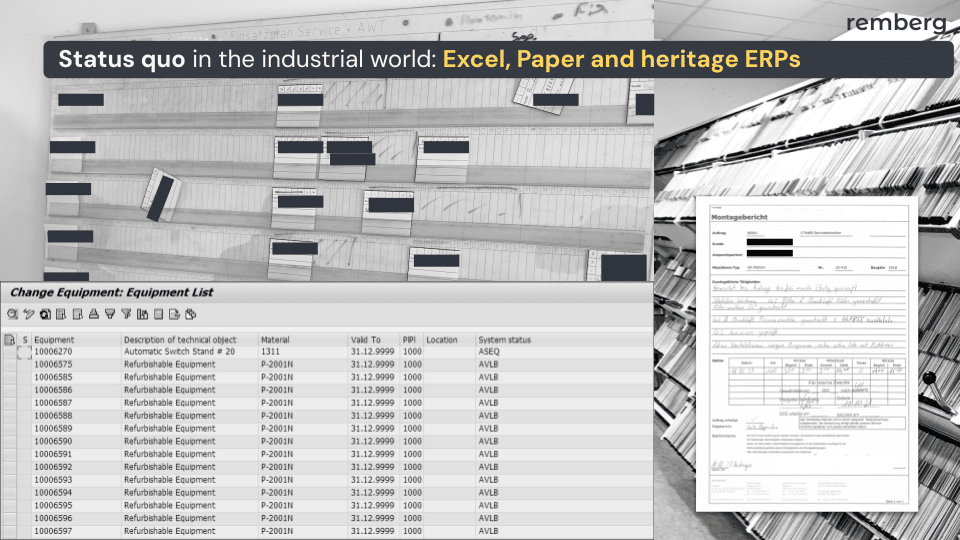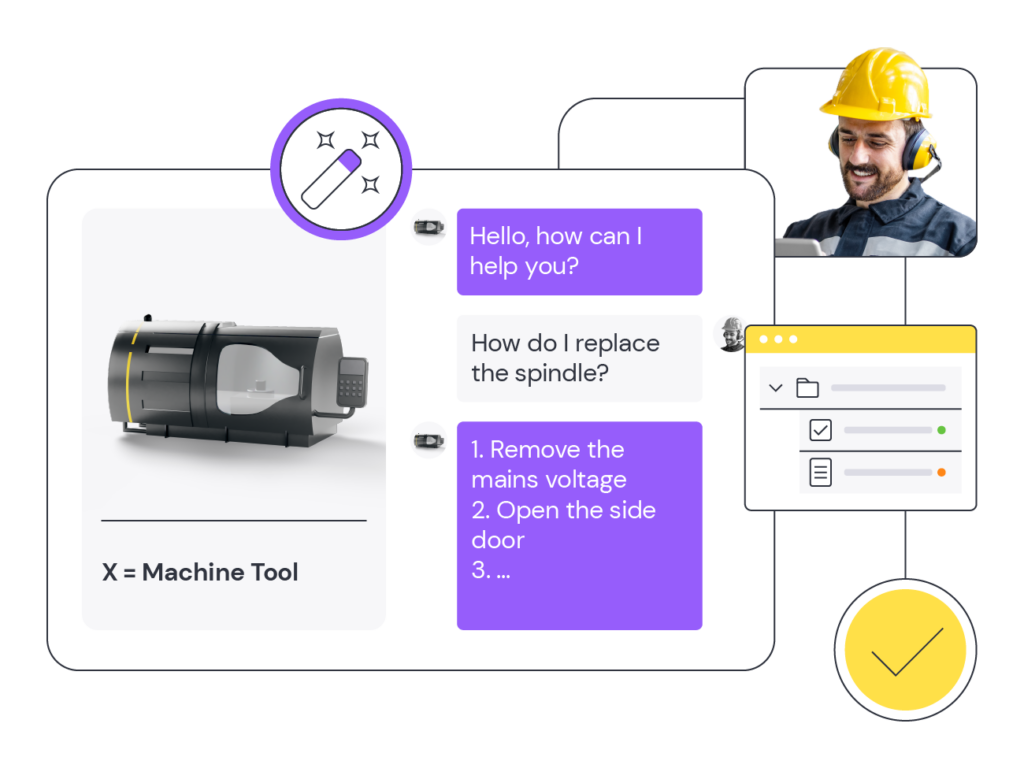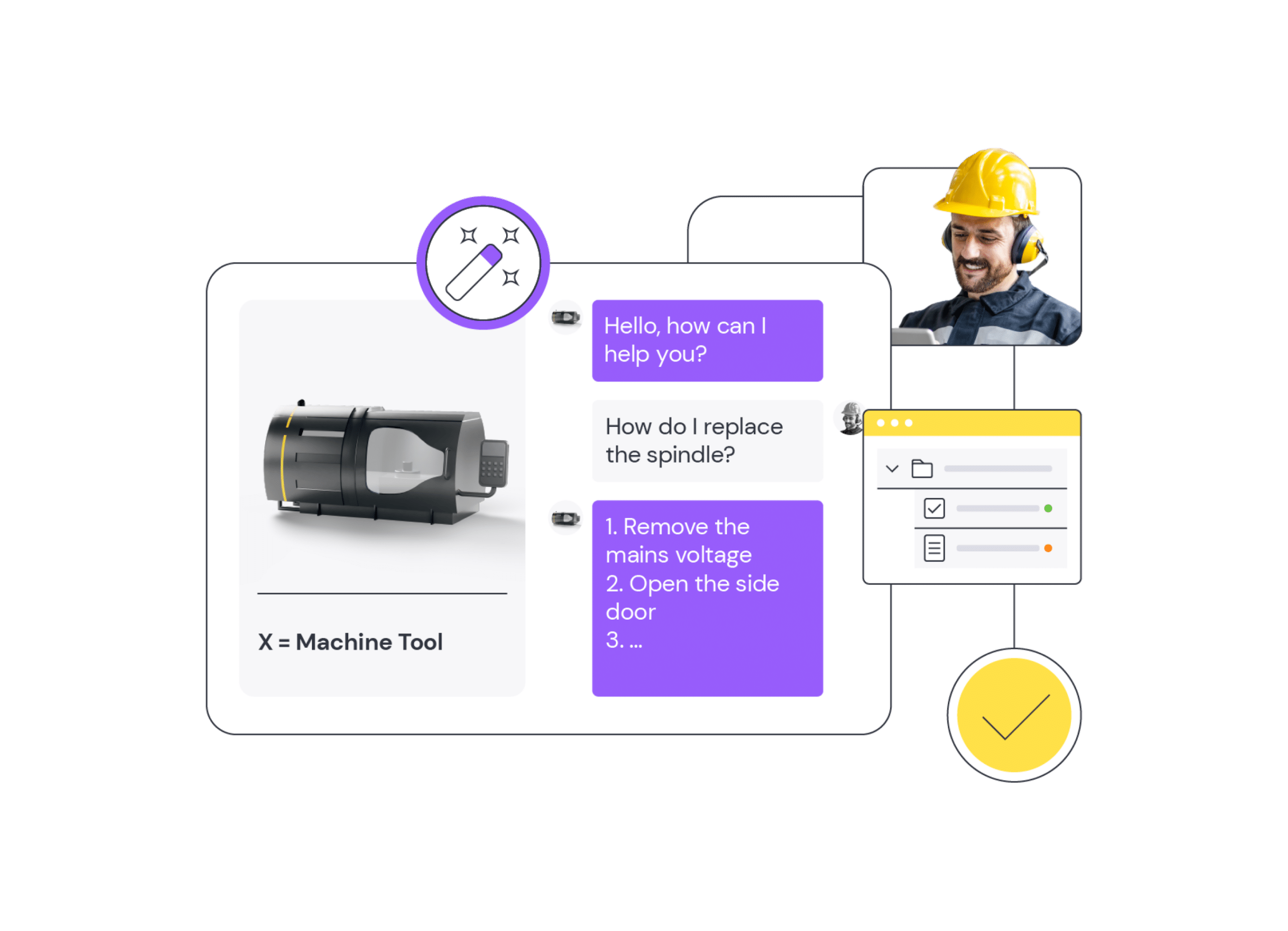Beating the status quo in the industrial sector is really tough. Why? Because paper offers a great user experience e.g. for technicians, even offline, Excel has 1bn+ monthly active users, is easy to use and heritage ERPs are like Swiss army knives, they somewhat get the job done. In the past, with modern software, we beat the status quo with a lot of resources (e.g. venture capital) by 2-3X which is good, but not great. Now, with AI, all of a sudden we can win over the status quo in the industrial and many other sectors by 10X.
The 3 Main Challenges of Industrial Companies, especially in Europe
All companies active in the industrial world either install, service, operate or maintain some form of assets – ranging from machines and equipment to facilities, vehicles or building technology. Most of these companies, especially in Europe, ask themselves how they are supposed to keep their operations up and running in the future since they are facing the same relentless challenges:
- Shortage of skilled, technical talent
- Increase in complexity of assets & equipment
- Competitive pressure on a global scale
After spending 5+ years in the uphill battle of building a fast-growing, globally relevant industrial tech company out of Germany fighting to solve those challenges, I have to admit: With the means we had so far, we were NOT yet able to solve these challenges to a degree I am satisfied with. Why? The answer is simple:
Beating the status quo in the industrial sector is really tough:
- Paper has a phenomenal user experience (UX) for technicians. It has been in the business for 2000+ years. It works in dirty environments, it has a great offline functionality and it does not have any bugs. It works for when a technician has repaired a machine and needs to document what she has done.
- Excel has 1bn+ monthly active users for a reason. It’s very flexible and it’s available in every company as a tool – it also works well offline. It’s used for planning overviews of who is doing what and when on which equipment.
- Heritage ERP Systems are like Swiss Army knives, they offer functionality for almost everything. If you try to cut a tree with it, you will get that done, it takes very long and the user experience is bad, but hey, it works.

How did we work up until now?
With modern software applications, mobile-first, API-first, a team focusing solely on UX for technicians, using the latest available web technologies, adding offline functionality and many more things you can imagine. Of course, if you throw enough resources at it (what we did with venture capital), you beat the status quo at some point by 2-3X which is also how you can build a good business here if you are patient enough.
But now, AI has fundamentally redefined the game.
AI beats the status quo by 5-10X in the industrial and many other sectors
Imagine you are a technician encountering an unfamiliar machine or equipment for the first time. You have absolutely no clue what to do in case it has a downtime. Historically, resolving issues with such equipment would involve sifting through hefty hundreds-of-pages manual or seeking out a more experienced colleague. Once you finally got it repaired you filled out a paper-based or Excel-based protocol on how long it took and what parts you needed so someone else in the back office would have to scan it and process it in the ERP later. These methods, while effective, are extremely time-consuming and some of them are very knowledge-intensive.
AI copilots as the future of service, operations and maintenance
With an AI copilot, technicians can simply ask the equipment questions and receive immediate, contextually accurate answers. For example, if a machine displays a blinking light, the technician can inquire about its meaning and learn that seven flashes with noticeable intervals indicate a faulty battery. Further, the AI Copilot can guide the technician through the process of changing the battery, combining information from various sources into a single, easy-to-understand response. In the future, every piece of equipment – no matter if industrial machines, robots, or even energy utilities like solar equipment, charging stations, building technology, or vehicles – will come equipped with an AI copilot.
The remberg AI copilot
To make this a reality we have launched the remberg AI Copilot to provide immediate technical assistance, solve technical issues relating to equipment more quickly, minimize downtimes, call up the entire knowledge of an asset at the touch of a button and thus also to reduce the enormous shortage of skilled workers in the field of technology on the front line – all around the clock.

How does the remberg AI Copilot work?
Implementing the remberg AI Copilot is a straightforward process involving three key steps:
1. Import Master Data: You can import all equipment and asset master data from existing systems, such as (heritage) ERPs, either via our REST API or CSV batch migration
2. Import Documentation & Files: You then import all relevant files and documentation and associate those with each asset through a bulk upload or REST API
3. Ask the remberg AI Copilot: Once the data and documentation are in place, you can start interacting with the Copilot asking questions e.g. to significantly reduce the time required to resolve technical issues.
What’s next? From AI-Assistance to AI-Action
Looking ahead, the remberg AI Copilot will be equipped with even more capabilities, integrating seamlessly with various other features of our product, the remberg XRM. We will move from AI-assistance to AI-action transforming the remberg AI Copilot then more towards an AI Agent e.g. solving tickets by itself, filling out forms and protocols, planning and dispatching technicians, creating maintenance plans for equipment and much more. Today, you can choose whether you only want the remberg AI copilot and or additional features.
How to use the power of AI for your assets & equipment?
To experience the transformative potential of AI for your equipment & operations, there are three ways to get started with remberg AI Copilot.
- Product Tour: On our website, www.remberg.com select the X = assets you want to manage with the power of AI and see how this may look for your equipment and teams
- Talk to my team: Schedule a meeting with us to discuss your specific requirements – click book a demo on the top right of our website. We’ll ask you a couple of questions in a MS Teams meeting and can set up the remberg AI Copilot for your needs.
- Reach out to me: I am learning something new every day in this space, happy to exchange on how you think about the future of AI copilots and AI agents in asset-heavy industries, text me on LinkedIn
What about data security & GDRP compliance?
In case you are worried that ChatGPT or alike will get all of your data: We do all of this in an environment with the highest degree of data security, hosted in Germany with GDPR-compliance in place.
Conclusion
The future of the industrial world is of course going to be digital, that was never the question. What has changed is that we can make that future happen much faster. AI is the key to a massively increased speed of digital adoption, simply because it unleashes 5-10X more value than the status quo. We should all make sure we are not missing out on this opportunity, especially in Europe, so let’s stop trying to find reasons to stay in the past. AI copilots like ours at remberg are at the forefront of the digital transformation. We invite you to challenge us with the complexity of your assets and operations. Let’s embark on this exciting journey together towards a smarter, more efficient and soon-to-be more digital, industrial future.
Best regards from Munich,
David Hahn
CEO, remberg


 Back
Back